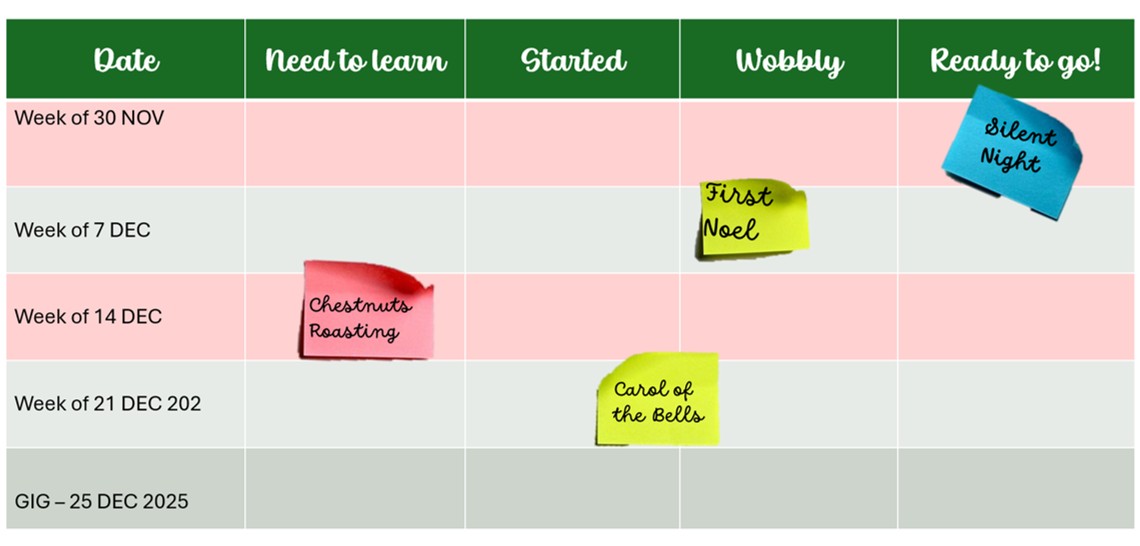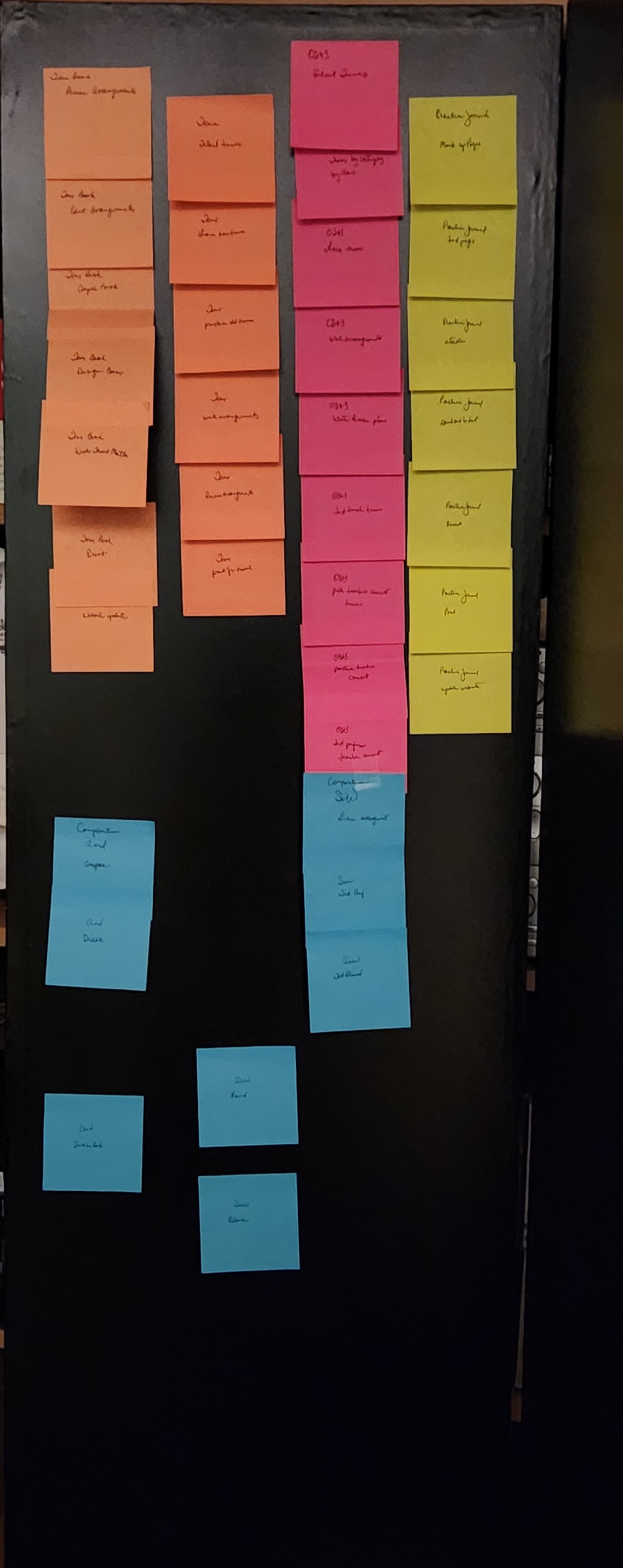It’s the week before Thanksgiving here in the US. This used to be the indicator that Christmas was coming. Now it’s more like Halloween starts the holidays countdown (but that’s a different diatribe!). I don’t know how you’re coming along in your preparations for playing throughout the holidays, but I find myself wishing I had an extra three weeks!
You might wonder how I know I need an extra three weeks – not two, not four, but three.* It’s because I can see where I am, where I want to be, and where I had planned to be at this point in time. (I originally typed “should be” but went with “planned” because should is such an evil, subversive word!).
How do I “see” this? I have a sticky system. Literally!
My system allows me to track each of the tunes I need to have ready for a holiday program(s) as they develop. It also allows me to see if something is just not going to be ready so I can replan for something that I will be able to play better. After all, the point of holiday gigs is to spread cheer and comfort – not to terrorize yourself trying to wow people with your brilliance! Save that for another time like competition or audition!

This graphic gives you an idea of what it could look like. And here’s a shot of mine just now.

You may have seen similar systems in your travels – this is much like kanban or scrum. Not surprising since I am a systems engineer when I’m not being a musician**, so of course I cross my tools between domains (goose/gander, etc.). The differences are that this is just for you, not a group (although you could use it for ensembles!), it is not as rigorous because we’re not building bridges (except ethereally) and we only need as much rigor as is required and not more, Finally, while on the one hand preparing music is a “project” on the other hand, it’s more than that – we’re making art not planning to pour cement or launch wonky code.
If you’re eager to start, you might want to know – what do you need to use this? Well…

First – you need sticky notes! You need as many colors as you think you need. Lined or unlined? It’s up to you!
Next, you need enough space for you to keep track of your work over time. I like the little stickies because I write small but if you need more room, use the bigger ones (they do come in sizes from 1.5 in x 2 in all the way up to 25 in x 30 in). Use the size that lets you write comfortably and fits in your usable space. I use a variety of spaces – a wall, the side of a bookcase, that photo shows one panel of a room divider and when I need to, I switch to a sheet of paper – depending on my mood and where I happen to be at the time (and if I need to take it with me). I write the name of the tune (and maybe the source if I’m reading) but you can put whatever else you decide to put there (maybe the key you’re playing in, etc.).
Now, you need a scale for time. Use whatever type of calendar you work best with. If I have a long time (e.g., tunes I might teach next year) I will use a monthly calendar. If it’s something more imminent (like the holidays) I use the week. I used to use a daily, but I found that kept me too focused on checking the box rather than learning the music. Frankly, for daily progress I use a journal so I can capture details that would just get lost on my big sticky board.
Now, you need a metric. I typically use what I have shown in the graphic – whether the tune is coming along, practically done, ready to go. This not only tells me how the tune is developing, it also helps me plan my practice – if I haven’t actually learned something at this point, it gets more attention so it can get “caught up”. You will always have some tune in this category of disrepair – how much you stress over it depends on how important it is (relative to the time you have to prepare). It’s important not to stress over these – if you’re not learning you’re not living!
You need maintenance. This tool will only help you if you set aside a little time to review and update it. In the graphic example, that would be once a week so you can see, identify, and enjoy your successes, replan your practice as needed, and keep your sanity. If you review too often, you’ll get lost in translation. This is a tool but it’s not a cudgel!
And finally, don’t forget to… Breathe.
Give it a try, play around with it. It’s not rocket surgery, but it also didn’t come down a mountain on stone tablets, so feel free to modify it so it can work for you! Then, let me know how it goes when you start. I’d love to hear what changes you made for yourself and how prepared you think you are for the holidays! Let me know in the comments!
* PS – I just learned that the em-dash is the exclusive province of AI…and me! I probably taught the model that. And I assure you, for good or bad, this is all me and NI (natural intelligence)
** Ha! I’m not sure I could be one without the other – being a musician makes me better at thinking systemically and being a systems engineer certainly informs how I think about, work with, and play music. Yet, I persist in pretending like they’re not on the same spectrum.